Some people enjoy growing tomatoes, but there’s more you can do to strengthen your gardening skills. By using an unusual but very effective way, you can make sure that your tomato plants get organic food all the time during the growing season. This method not only makes plants healthy, but it also increases fruit production, which means your tomatoes will be sweeter and taste better. Let’s look more closely at this way of gardening and see how it can help you get a bigger, better crop.
Planting Area Preparation for Maximum Growth
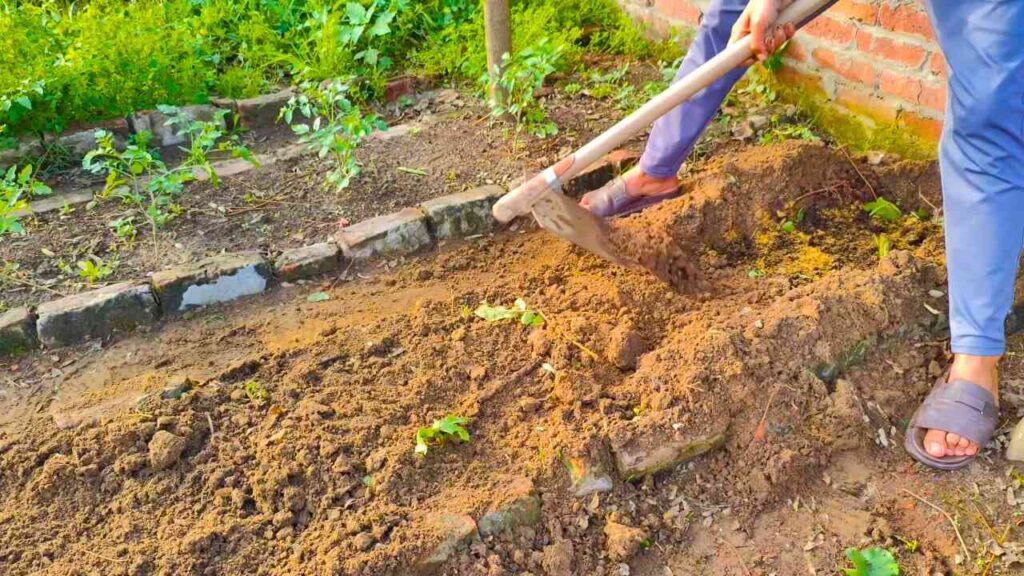
The first step is to prepare the planting area. In the image demonstration, the planting beds are made to look like containers with holes in the bottom. The structure is there on purpose so that the tomato plants’ roots can grow deeper into the ground. This design makes the dirt drain better and lets nutrients get to the roots easily. The plant is stronger and more stable when its roots can grow deeper. This trait is important for both fruit production and the plant’s general health.
Digging a large, deep hole in the desired planting location is crucial. The hole’s size is important because it makes sure there is enough room to add the organic matter that the plant will need to grow and thrive. First, prepare the hole, then fill it with organic matter to act as natural fertilizer.
Secret Ingredient: Kitchen Waste as a Long-Term Fertilizer
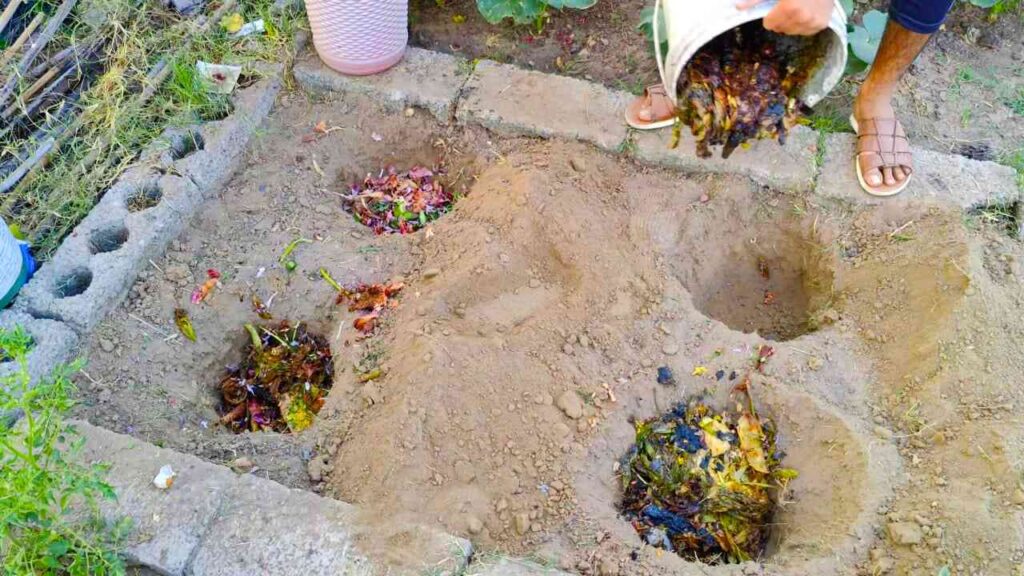
One great thing about this method is that it uses kitchen trash as the main source of nutrients for your tomato plants. You don’t have to throw away fruit peels, veggie peels, or other plant-based kitchen waste; you can turn them into excellent organic fertilizer instead. Over time, these scraps break down on their own, releasing important nutrients like nitrogen, phosphorus, and potassium into the soil. In forests, organic waste breaks down naturally, feeding the plants nearby as it does so. This slow decomposition is like that.
Though cooking waste is useful, there are some things you shouldn’t do with it. Cooked food, cheese, and meat may attract pests and take longer to decompose. It’s best to stick to raw, plant-based trash. By putting many food scraps in the hole, you make it possible for the tomato plants to get nutrients when they need them, which helps them grow steadily and healthily.
Epsom salt can help the soil grow better.
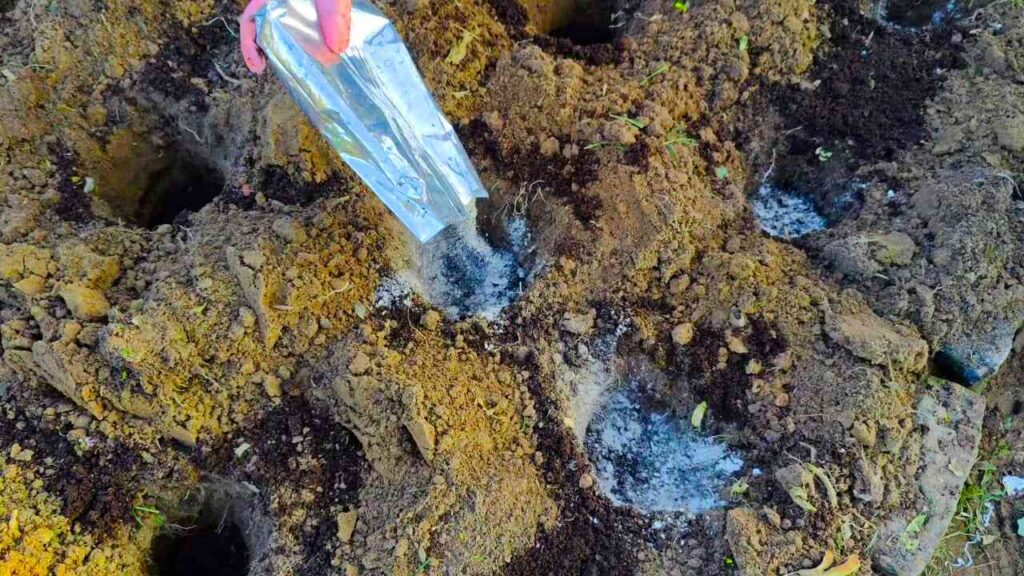
After putting in the kitchen trash, sprinkle Epsom salt on top of it. Epsom salt is a very useful thing for plants that people often forget about. It has a lot of magnesium and sulfur, which are two important nutrients for tomato growth. Magnesium is an important part of photosynthesis, which helps plants turn sunlight into energy. Sulfur, on the other hand, makes food taste better and helps plants take in nutrients better.
Putting Epsom salt on top of the cooking waste makes sure that the plant can get these important nutrients as it grows. The cell walls of the tomato plant get stronger with magnesium, which makes it less likely to get sick. Sulfur, on the other hand, makes the tomatoes taste better by making them sweeter and more colorful.
Adding compost is the main step to making soil healthy.
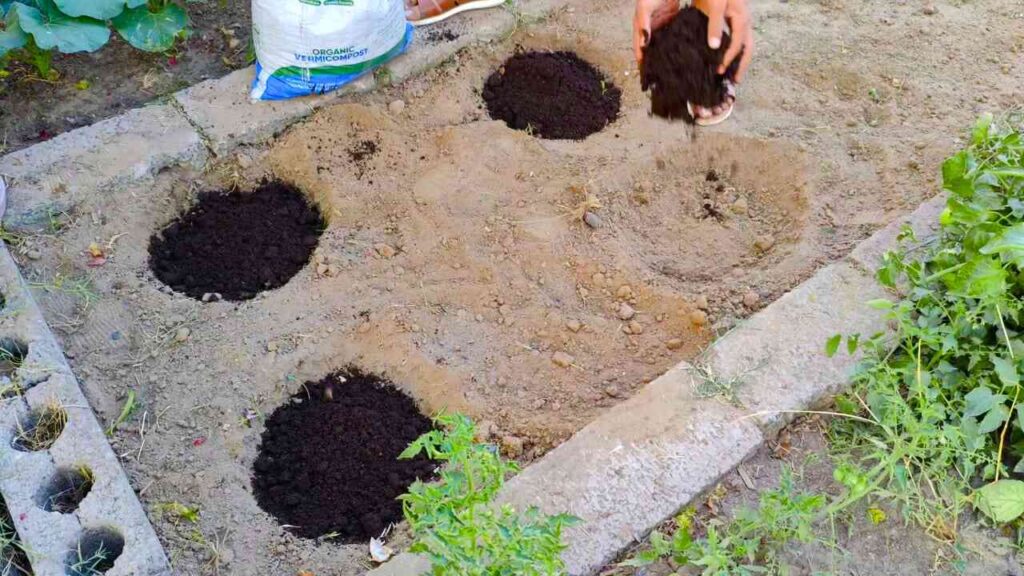
In the next step, compost will be added on top of the kitchen trash and Epsom salt. Another important part of this method is compost, which has beneficial bacteria that help break down the organic matter faster, so nutrients can get to the roots of the plant faster. This layer also makes the structure of the earth better, which helps it hold on to water while letting extra water drain away. By adding compost, you speed up the process of breaking down the material and give your tomato plants a steady source of nutrients.
Adding compost to dirt is another excellent way to keep it healthy over time. It increases the activity of microbes, which improves the cycle of nutrients and strengthens the plant’s immune system, making it less likely to get sick. You’re not only feeding the plants with compost; you’re also improving the soil’s health, which will help with future gardening projects.
Covering the Hole: Nutrient Sealing
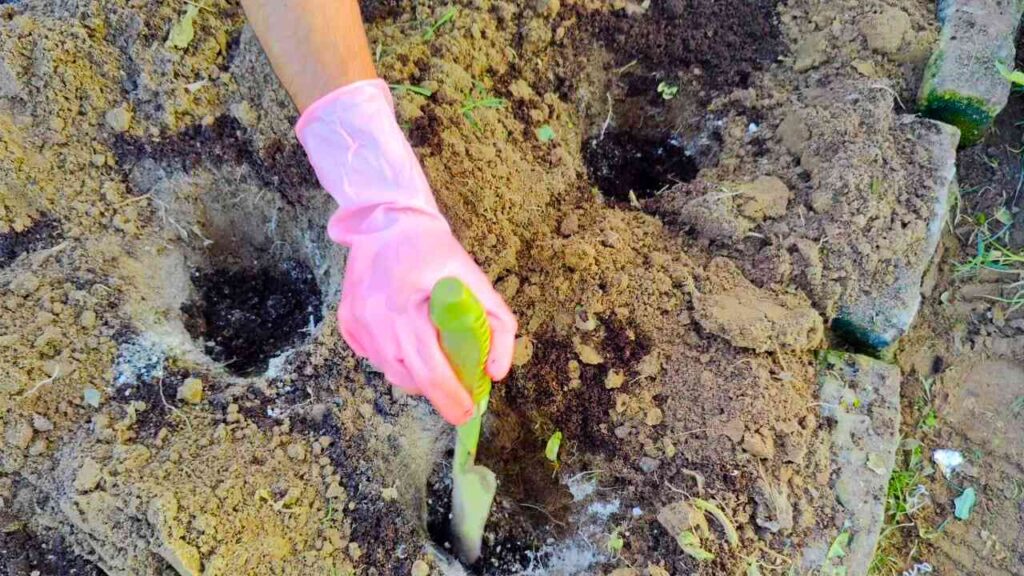
After putting down the compost, Epsom salt, and kitchen waste, it’s time to fill in the hole with the dirt you dug up last time. This step is critical because it keeps the nutrients in and stops bad smells from leaving as the organic matter breaks down. Gently press down on the dirt to get rid of any air pockets and make sure it is loose enough for the roots to grow in.
Now is the time to add another layer of compost on top of the dirt. This second layer is like a slow-release fertilizer that keeps giving the tomato plants food over time. It also helps the earth hold on to water, so plants don’t need to be watered as often and stay healthy all through the growing season.
How to Plant Tomatoes: How to Give Your Seedlings the Best Start
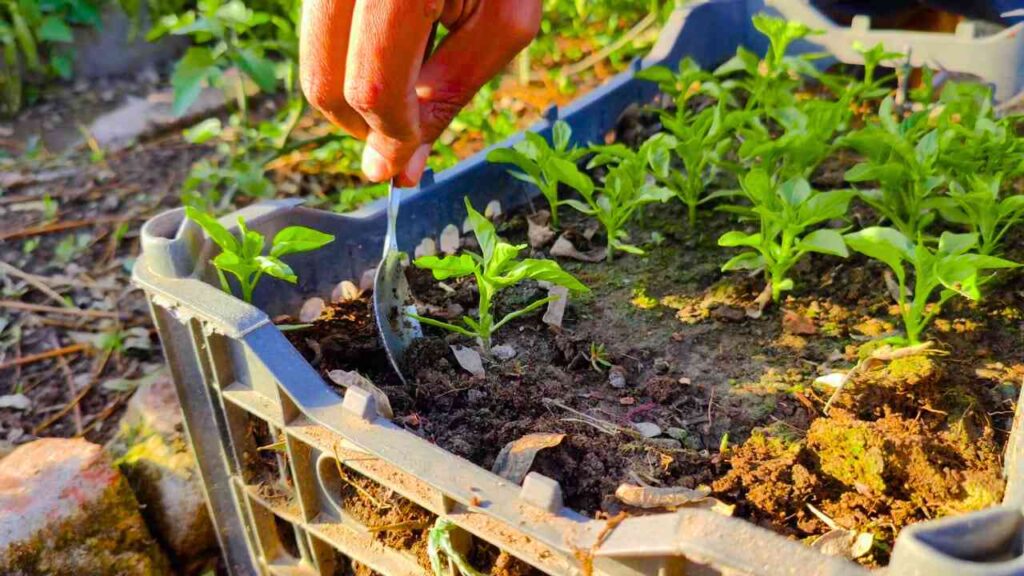
Now that the hole is ready, you can put in your tomato seedlings. When you choose saplings, choose ones with strong, healthy stems and roots that are well-developed. When planting your tomatoes, it’s best to bury them deeper than you think. This strategy makes the plant stronger by encouraging more root growth. Planting lower makes the base more stable, which helps the plant handle wind and other environmental stresses better.
After putting the plants down, give them a lot of water to settle the soil around their roots. This approach also helps get rid of any air bubbles that might get in the way of root growth. Giving the plants enough water right after planting is crucial to help them adjust to their new environment.
Nutritional Compost Tea for Growth
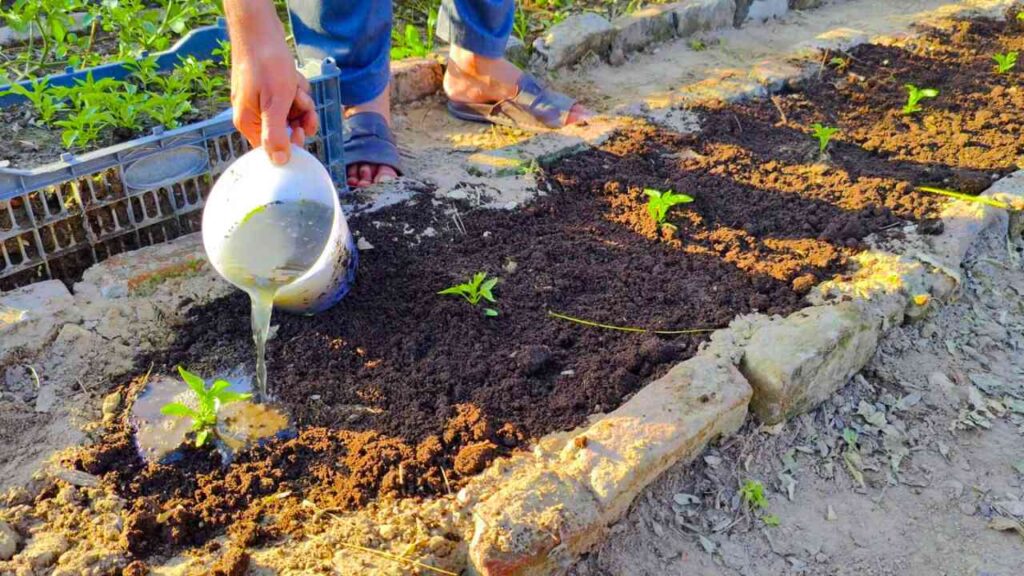
If you want to give your plants an extra boost, you could use waste tea after they are planted. By letting compost steep in water for a while, you can make compost tea, a healthy drink. This process takes beneficial bacteria and nutrients out of the compost so that your tomato plants can use them. Not only does compost tea help plants grow well, but it also boosts their immune systems, making them less likely to get sick or be eaten by bugs.
If you use compost tea on a regular basis, it will boost microbial activity in the soil. Such activity will make nutrients more available and help your garden stay healthy in the long run.
The Self-Sustaining Continuous Decomposition Process
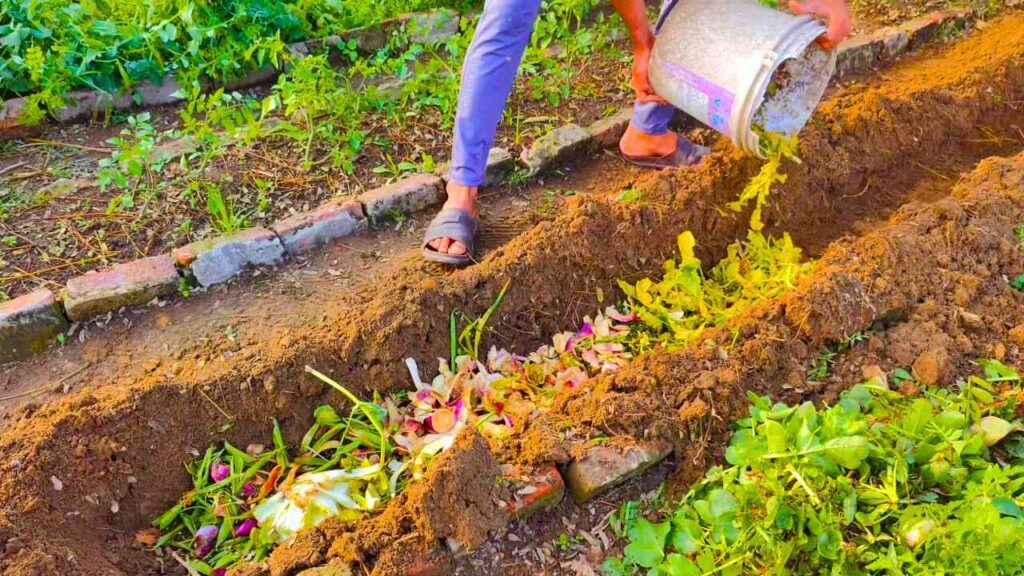
The kitchen waste you buried will continue to break down slowly as the tomato plants grow, adding nutrients to the earth over time. This procedure means that your plants will always have a healthy source of food, so they won’t need to be fertilized all the time. The plants are more likely to focus on making fruit instead of too many leaves because the nutrients are released slowly. This approach makes the plants stronger and the tomatoes sweeter and tastier.
This method is beautiful because it is so easy to use. By using compost, Epsom salt, and kitchen waste, you make a system that can last and keep running on its own. The soil will automatically feed the plants. The process not only cuts down on the need for chemical fertilizers, but it also makes the soil healthier, which means your garden will grow well for years to come.
Conclusion: Growing Tomatoes Naturally and Effectively
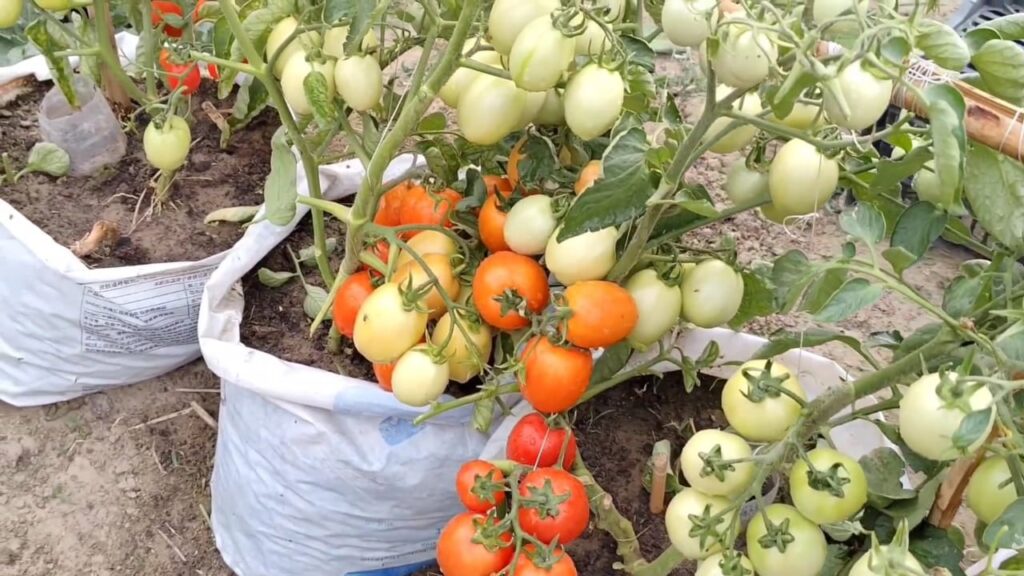
This approach is an interesting and easy way to grow tomatoes. By using natural things like compost, food waste, and Epsom salt, you make a place where plants can naturally grow and thrive. The garden is now stronger, and the tomatoes are sweeter, tastier, and more plentiful. Also, you’re doing good things for the earth by gardening in a way that doesn’t harm it.
If this method worked for you, be sure to check out our channel for more natural planting tips. To stay up to date on the best ways to grow an eco-friendly yard, don’t forget to like, share, and subscribe!

